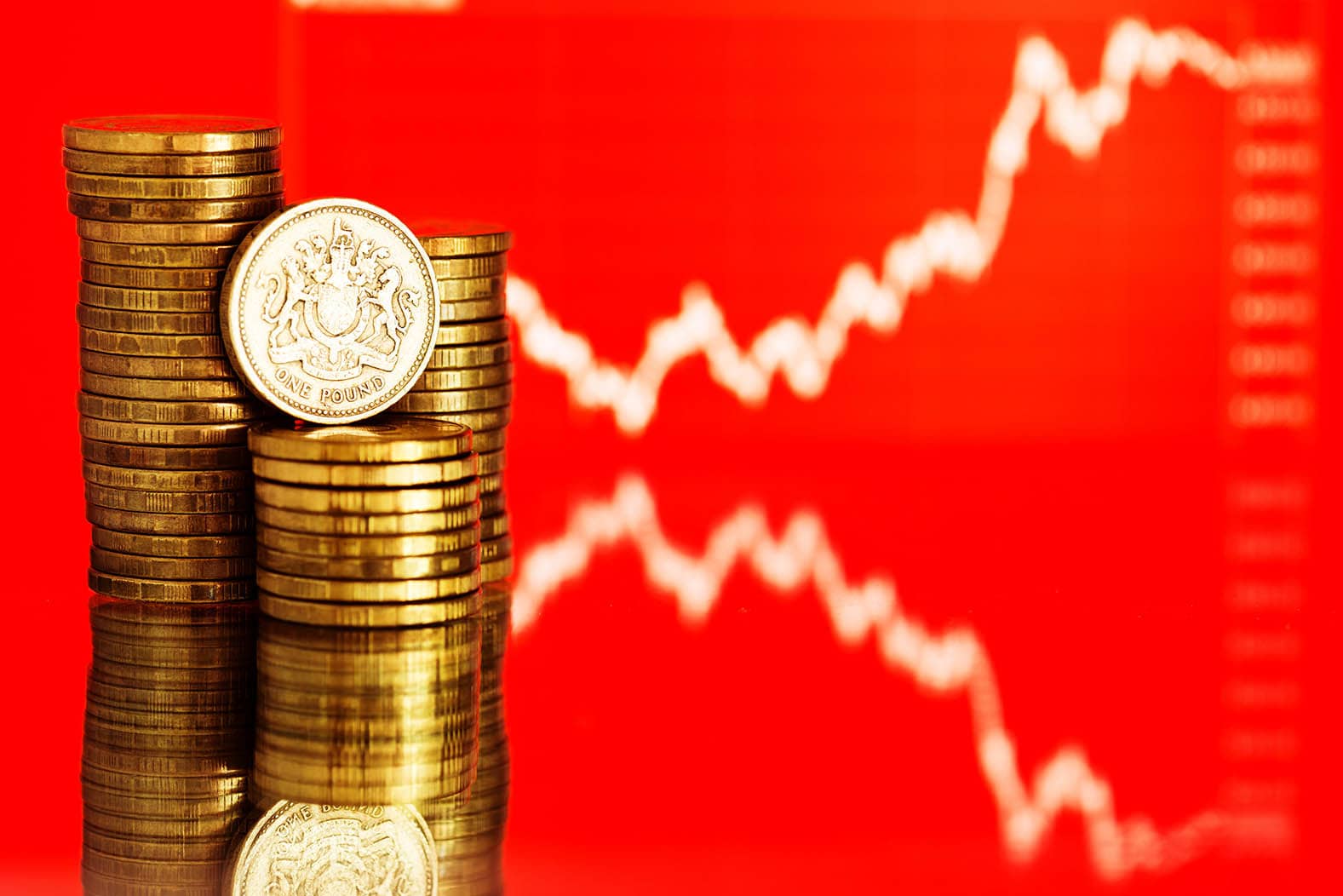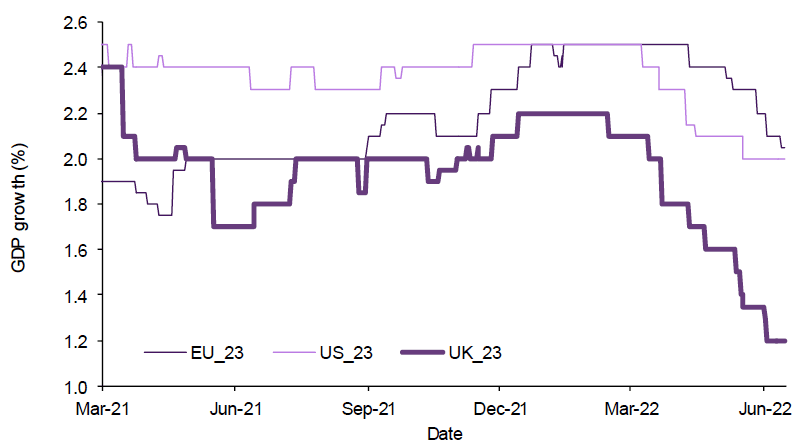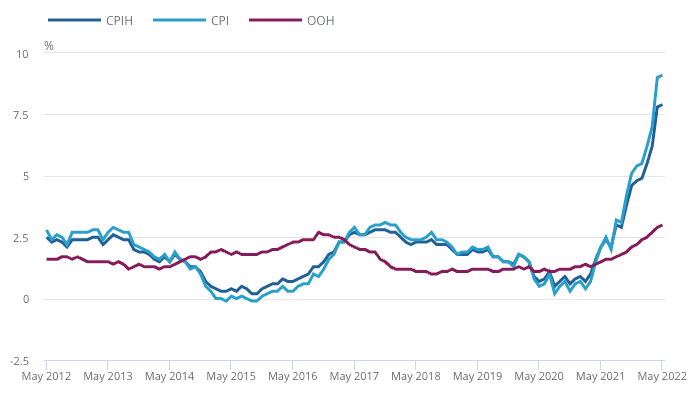Pound Sterling Nears a "Peak Pessimism" Moment says NatWest, see Limited Downside against Euro and Dollar
- Written by: Gary Howes

Image © Adobe Images
Peak investor pessimism towards the British Pound could be nearing say analysts at NatWest Markets who now see limited downside against both the Euro and Dollar for the UK currency.
"For Sterling, our primarily focus is on whether the point of peak pessimism has been reached," says Paul Robson, Head of G10 FX Strategy at NatWest Markets.
He says the Pound's prospects will depend on whether a challenging UK economic outlook is now fully priced by the market.
The view confirms UK growth expectations relative to elsewhere will continue to be a significant driver of Pound Sterling performance.
"It leaves the outlook very data dependent. UK growth expectations have been revised downward on both a relative and absolute basis, with the main driver the global price shock," says Robson.
As the below chart suggests, the market is pessimistic on the UK's prospects relative to those of the EU and U.S.
Above: GDP consensus expectations for 2023. Source: Bloomberg, Natwest.
Reflecting falling growth expectations the Pound to Euro exchange rate has lost 2.30% in value during 2022, while the Pound to Dollar exchange rate has lost 9.20%.
But Robson points out other economies face economic challenges, particularly the Eurozone which is exposed to a similar energy price shock to the UK.
The U.S. is meanwhile increasingly forecast by economists to fall into recession as the Federal Reserve tightens monetary conditions to the extent it kills growth.
"Others face a similarly difficult outlook," says Robson.
NatWest's currency strategy team now believes the point of peak UK pessimism is near, "which leaves us seeing value in GBP/USD around 1.20".
Compare Currency Exchange Rates
Find out how much you could save on your international transfer
Estimated saving compared to high street banks:
£25.00
Free • No obligation • Takes 2 minutes
NatWest's strategists are also reluctant "to chase" the Euro higher against the Pound at current levels, saying the European Central Bank risks causing funding stresses in some weaker Eurozone countries if it pursues higher interest rates. (Set your FX rate alert here).
But Robson acknowledges becoming an outright Sterling bull will remain difficult given the weight of the bearish consensus.
"It seems as if we are clearly in a very small minority and the burden of proof is very much on us," says Robson.
Relentless pessimism towards the UK economy and Pound Sterling was encapsulated by a midweek article on Bloomberg titled, "Brexit’s Legacy Is Hotter UK Inflation Risk for Years Ahead".
The article cited big-name analysts at Citi and Bank of America who remain bearish on UK assets, including Sterling, arguing the shock of Brexit and the belief it has permanently undermined the UK economy.
Sour sentiment is reflected in the broader investor community with the net 'short' bet against the Pound held by investors rising to its highest levels since September, 2019 according to CFTC data as sentiment deteriorated.
"Sterling has few friends when you wander around seeing clients," says Société Générale's head currency analyst Kit Juckes when meeting investors in Athens recently.
Above: "Annual CPIH inflation rate highest since April 1991 CPIH, OOH component and CPI 12-month inflation rates for the last 10 years, UK, May 2012 to May 2022. Source: Office for National Statistics."
He says the Pound might have stabilised against the Euro of late but, "when everyone is bearish, it’s hard to find new sellers of sterling."
"I expect we’ll break that post-referendum low in the coming years," says Juckes.
But hints of a potential shift in fortunes for the British Pound came midweek with the release of the latest set of UK inflation numbers which revealed growth in the all-important Core CPI declined to 5.9% year-on-year in May, from 6.2% in April.
"European FX are trading in line with stagflation," says Viraj Patel, Macro Strategist at Vanda Research, "so in-line/softer CPI is good for GBP".
Arno Venter, Market Analyst at Financial Source is in agreement, saying stagflation fears are very high for the UK, "with probabilities of recession growing by the week".
"With so much bad news priced in, incoming news risk is asymmetrical, meaning positive surprises in growth data (like incoming flash PMIs) could trigger bullish reactions for Sterling," says Venter.
He explains focus for Sterling isn't just on Bank of England policy right now (how fast and how far will they hike), but on where stagflation fears go.
"The UK is facing one of its biggest cost of living squeezes in history, lower-than-expected inflation prints could counterintuitively be a positive driver for the currency (lower CPI means lower stagflation risk)," says Venter.
Beyond the 'peak pessimism' thesis, Robson says he also expects support for Pound exchange rates to come from the fact that long-term valuations are starting to look attractive.
"Exporter hedging, foreign multinational repatriating less and private equity firms hedging balance sheets rather than costs and revenues can support GBP/USD in the low 1.20s," he says.
Compare Currency Exchange Rates
Find out how much you could save on your international transfer
Estimated saving compared to high street banks:
£25.00
Free • No obligation • Takes 2 minutes






